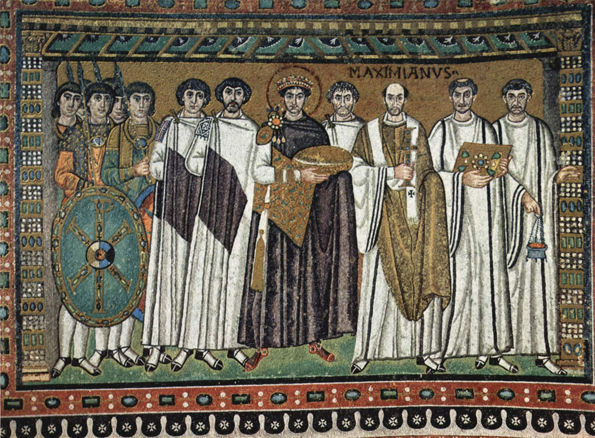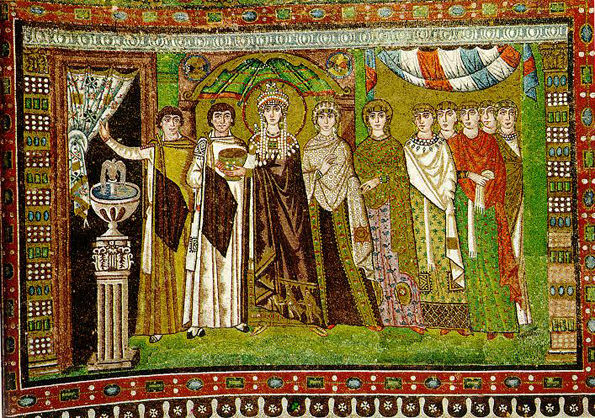The pinnacle of early imperial Byzantine dress is best seen in the mosaics of Emperor Justinian and Empress Theodora at the Church of San Vitale in Ravenna, Italy (ca. 547 A.D.). Facing opposite one another in the apse of the church, each mosaic depicts the main figure bedecked in finery and accompanied by a retinue.
Court of Emperor Justinian with (right) archbishop Maximian and (left) court officials and Praetorian Guards; Basilica of San Vitale in Ravenna, Italy. Image via Wikimedia Commons; © The Yorck Project: 10.000 Meisterwerke der Malerei. DVD-ROM, 2002. ISBN 3936122202. Distributed by DIRECTMEDIA Publishing GmbH.
Emperor Justinian is shown dressed in a royal purple chlamys and jeweled stemma. He raises his hands in offering as he holds a gold paten, displaying his patterned tablion, a supplemental textile bearing a repeat pattern and most likely produced on a drawloom. He surrounds himself by the more austerely dressed bishops and by his top general, Belisarius. Soldiers at the edge of the frame reinforce the emperor's military successes and his position as commander.
Empress Theodora and Her Court; Basilica of San Vitale in Ravenna, Italy. Image © Wikimedia Commons user Neuceu
Empress Theodora, whose uncertain background was criticized by the historian Procopius and others as being one of disrepute, is also draped in a royal purple chlamys over an embroidered gunna—the etymological root of the modern-day English word "gown." The bottom edge of her chlamys features a tapestry-woven depiction of what has been convincingly identified as the three magi bearing gifts; the actual garment was most likely woven with gold-wrapped thread. Theodora herself holds up a jeweled chalice, reaffirming her identity as the generous patron of the building. Other paraphernalia include the jeweled maniakis collar and crowning stemma, with elaborate pearl-and-gem prependoulia hanging to her shoulders. She is flanked by Antonina, wife of Belisarius, and by attendants dressed in drawloom-woven gowns of silk featuring bright colors, possibly of Sasanian manufacture, further embellished with tapestry-woven areas similar to those found at Panopolis (Akhmim, Egypt).
In both portraits, the rulers are dressed to identify themselves with the saints and prophets surrounding them in mosaic decoration, and to establish their eternal presence among the divine.
Bibliography
Ball, Jennifer L. Byzantine Dress: Representations of Secular Dress in Eighth- to Twelfth-century Painting. New York, NY: Palgrave Macmillan, 2005.
Garland, Lynda. Byzantine Empresses: Women and Power in Byzantium, A.D. 527–1204. Routledge, 1999.
McClanan, Anne. Representations of Early Byzantine Empresses. New York, NY: Palgrave Macmillan, 2002.

